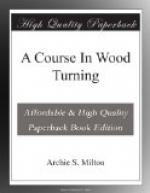When scraping is to be employed, it should be done with only those tools that are made for that purpose, i.e., Square Nose, Round Nose, Spear Point, Right and Left Skew. The handling of these tools will be found easy. The only point to remember is that they should be held flat on the tool rest and parallel to the bed of the lathe when in use.
In general practice the ordinary skew chisel should not be used as a scraping tool, for the cutting edge is not sharpened to withstand the heavy strain required by such work. Should it be necessary, however, to use a skew chisel as a scraper, the tool should be held so that the top grind is parallel to the bed of the lathe while in use.
INTERNAL BORING
In roughing out the center for Napkin Rings, Jewel Boxes, etc., the quickest method is to work it out with a small gouge.
Place the gouge on the rest parallel to the bed of the lathe, having the point even with the center of the stock.
Force the gouge into the wood until a hole is bored to the depth required. If the hole is deeper than 1”, remove the tool often and clear out the shavings in order not to burn the point.
In order to enlarge the hole to the proper size the point of the gouge is pressed against the left side of the hole a little above the center and a shearing cut is taken. To obviate the danger of the tool catching, all cuts should start from the back of the hole and proceed toward the front.
[Illustration: Fig. 22.]
B-III—8-a. Sphere
After the sphere is turned as nearly perfect as is possible when working between centers (Steps 1 to 4) it is cut free from the waste stock and is centered in a chuck.
The chuck is made of any soft wood and should be cut in the end grain, which will insure equal pressure on all sides. Equal pressure cannot be obtained if the Chuck is cut in cross grain wood, owing to the tendency of side grain to give more than the end grain. The sphere should be forced into the chuck with slightly over half protruding. Very thin cuts should be taken and the sphere should be revolved one-quarter turn after each until true. As the sphere becomes smaller during the cutting, it will be necessary to cut the face of the chuck down and bore the hole deeper and smaller in order to keep more than half of it protruding at all times.
[Illustration: Mirror (See Pages 299-301).]
To remove the sphere tap the chuck lightly with a hammer just above it, at the same time pull out on the sphere.
CHAPTER XI
SPIRAL TURNING
Spiral turning is a subject that has received very little attention by most schools in which wood turning is taught. Spiral work is seen in antique furniture and also in the modern furniture of the present day. It seems that it takes the wheel of fashion about a century to make a complete turn, for what our forefathers neglected and destroyed the people of the present day value and cherish.




